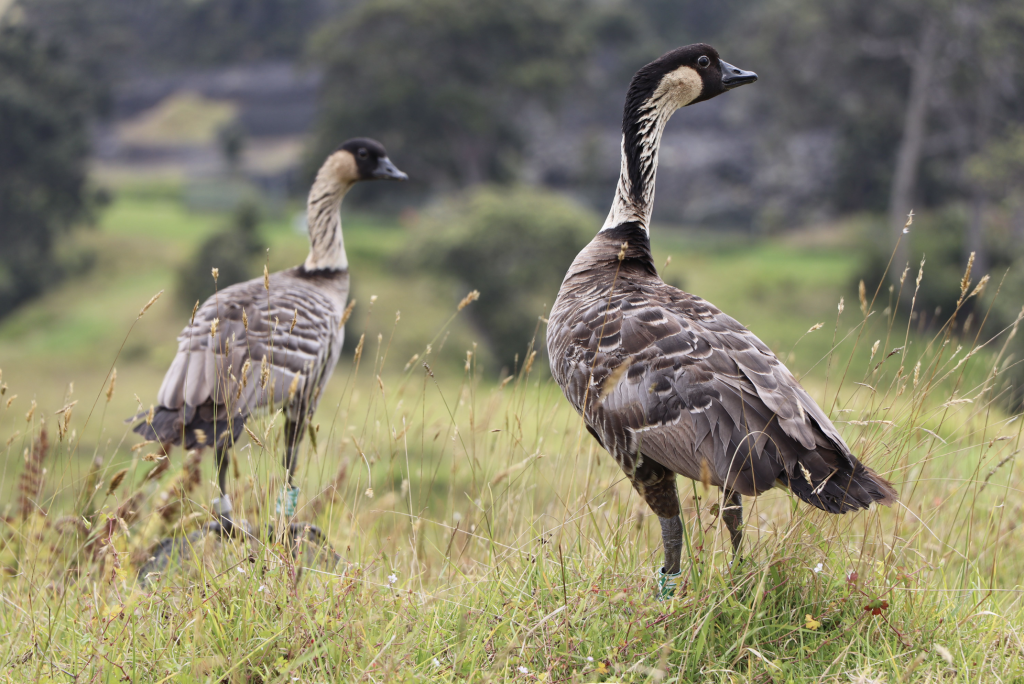State honors Hawaiʻi Wildlife Center for 10 years treating 3,000 birds

For its 10 years of service and dedication to the care of native birds and wildlife, the Hawai‘i Wildlife Center was honored on Friday with an award from the state Department of Land and Natural Resources.
Department Chair Suzanne Case presented the Hawaiʻi Wildlife Center with a DLNR & YOU Citizen Conservationist Award.
The wildlife center currently is treating an average of 20 to 30 patients a day. Many of the injured birds and bats that arrive were hurt by things people created, like golf balls, power lines, cars, guns and poisons. Cats, dogs, mongoose and rats also threaten the forest birds and seabirds.
“Though the wildlife center is on Hawai‘i Island, injured birds come from all the other main islands,” Case said. “Each year, from O‘ahu alone, HWC responds to 600 to 700 Wedgetail shearwaters, with those needing longer-term care being flown to the main Kap‘au facility for assessments, rehabilitation if necessary, and release.”
More than a decade ago, Hawaiʻi Wildlife Center President and Founder Linda Elliott became concerned Hawai‘i was the only state in the country without a wildlife response center for downed birds and started the center in Kapa‘au on the Big Island.
“Here we were, working in the endangered species capital of the world and we lacked a care resource for our native wildlife,” she said. “In the 1990’s it became my mission to fill this need. Now 10 years after opening, we have treated 3,000 feathery patients and a few bats.”

Now through mid-December is the time of year when shearwaters are downed. Demonstrating the center’s statewide reach and influence, Elliott said: “The shearwater fall-out season keeps us really busy, as does the manu-o-Kū program in urban Honolulu. Also known as white or fairy terns, orphans that can’t be returned to their nests, are flown to us and then in partnership with the Honolulu Zoo, we do a soft release.”
The stories of treatment, care, rehabilitation and hopefully release are boundless. In August, Hawaiʻi Wild Center veterinarian Dr. Juan Guerra joined Raymond McGuire of the DLNR Division of Forestry and Wildlife to release a pair of nēnē (native Hawaiian geese) into the Hawai‘i Island
“Our ultimate goal is to get birds back out in the wild,” Dr. Guerra said. “Each time we release birds it’s a renewal to my spirit. We have good days and bad days at the center. Some days we have to help a bird by ending their suffering. Other days we get to experience the triumph of release.”
Elliott said last year 88% of the birds and bats the center cared for by the Hawaiʻi Wildlife Center were either released or are in permanent care.
“In wildlife rehabilitation, typically success rates can be around 50%,” she said. “It depends on the health of the animal. The sooner it’s found, the sooner we get it into care, the better the prognosis.”
In addition to the hospital building and visitor information exhibits, the grounds have numerous aviaries. In one is three-year-old Maka‘io, a native Hawaiian hawk (i‘o). He arrived at the wildlife center with an eye injury and a wing injury. The wing healed, but he’s blind in the right eye.

“This bird can fly,” Dr. Guerra said. “Birds of prey, like ‘io, need to have binocular vision so they don’t miss. They don’t do well in the wild if they can’t see with both eyes.”
He exercises Maka‘io daily to prepare him for moving into his own aviary in the future, where thanks to his training with the good doctor, he’ll be able to fly wherever he wants.
“We want to provide him the best life possible and as much opportunity to make his own choices,” Guerra said.
“That is the overriding philosophy and result of everything the Hawai‘i Wildlife Center does,” Chair Case said. “We are proud to have them as partners in the vital work of caring for our native wildlife.”



